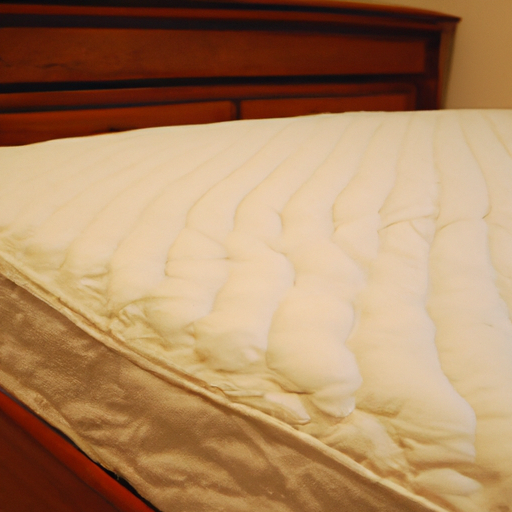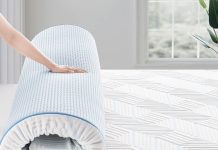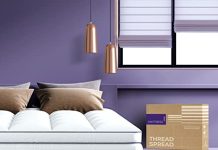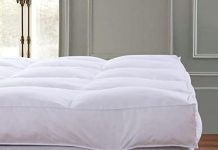Is your sleep falling flat? Is it lacking the comfort and support you crave? If so, then it may be time to consider a mattress topper. This simple addition to your bed can transform the way you sleep, providing an extra layer of cushioning and support to ensure a restful night’s sleep. But how do you know if you actually need one? In this article, we’ll explore the signs that indicate it’s time to invest in a mattress topper. So, let’s dive in and discover how this small yet mighty accessory can make a big difference in your sleep quality.
Review contents
Signs that your mattress needs a topper
Uncomfortable sleeping experience
If you find yourself tossing and turning throughout the night, unable to get comfortable, it may be a sign that your mattress needs a topper. A mattress topper can add an extra layer of cushioning and support, providing you with a more comfortable sleeping surface.
Worn-out or sagging mattress
If your mattress has seen better days and is starting to show signs of wear and tear, a mattress topper can help extend its lifespan and provide some much-needed support. A topper can help to redistribute your body weight evenly, minimizing the impact of sagging or worn-out areas.
Presence of pressure points
If you wake up with aches and pains in certain areas of your body, such as your shoulders, hips, or back, it could be a sign that your mattress is not providing adequate pressure relief. Adding a mattress topper can offer extra cushioning and alleviate pressure points, allowing you to wake up feeling refreshed and pain-free.
Allergies or sensitivities
If you suffer from allergies or have sensitivities to certain materials, a mattress topper can act as a barrier between you and your mattress. Look for hypoallergenic options that are resistant to dust mites and mold, as well as ones that are made from natural or organic materials.
Excessive motion transfer
If you share your bed with a partner or pet, you may be familiar with the problem of motion transfer. A mattress topper can help minimize the transfer of motion, allowing you and your partner to sleep undisturbed even if one of you tosses and turns throughout the night.
Inadequate support
If you feel like your mattress lacks support or if it is too firm for your liking, a mattress topper can provide the extra cushioning you need. Look for toppers made from materials such as memory foam or latex, which offer excellent support and contouring to your body.
Temperature regulation issues
If you find yourself waking up hot and sweaty during the night, your mattress may be to blame. Some mattresses can retain heat and disrupt your body’s natural temperature regulation. Look for mattress toppers that have cooling properties, such as gel-infused memory foam or natural materials like wool, which can help regulate your body temperature and promote a more comfortable sleep environment.
Mattress firmness preference
Everyone has different preferences when it comes to mattress firmness. If your mattress is too firm and you prefer a softer sleep surface, a mattress topper can help adjust the firmness level to your liking. Choose a topper with a softer material, such as memory foam or down, to provide that extra plushness you desire.
Noise and creaking sounds
If your mattress is making noise every time you move, it can be disruptive to your sleep. A mattress topper can help absorb some of the sound and reduce the creaking noises, allowing for a quieter and more peaceful sleep.
Budget constraints
If the idea of buying a brand new mattress is not within your budget, a mattress topper can be a cost-effective solution to improve the comfort and support of your current mattress. Toppers are generally more affordable than buying a new mattress and can provide an instant upgrade to your sleep experience.
Factors to consider before purchasing a mattress topper
Material and quality
When choosing a mattress topper, consider the material and quality of the product. Different materials offer different benefits, so choose one that aligns with your needs and preferences. Look for high-quality materials that are durable and will withstand regular use.
Thickness and density
The thickness and density of a mattress topper can greatly affect its comfort and support. Thicker toppers generally provide more cushioning, while denser ones offer better support. Consider your body weight and sleep position when choosing the thickness and density to ensure optimal comfort and spinal alignment.
Body weight and sleep position
Your body weight and sleep position play a significant role in the type of mattress topper that will work best for you. Heavier individuals may benefit from a thicker and denser topper to provide adequate support, while lighter individuals may prefer a thinner and softer topper for added comfort.
Allergies and sensitivities
If you have allergies or sensitivities to certain materials, make sure to choose a mattress topper that is hypoallergenic and resistant to dust mites and mold. Look for certifications such as CertiPUR-US or Oeko-Tex to ensure that the topper meets stringent standards for environmental safety and low chemical emissions.
Temperature regulation
If you tend to sleep hot, look for a mattress topper with temperature-regulating properties. Materials such as gel-infused memory foam or natural fibers like wool can help wick away moisture and maintain a cool sleep surface. Consider your climate and personal preferences when selecting a topper with temperature regulation features.
Motion isolation
If you share a bed with a partner or pet, consider a mattress topper with good motion isolation properties. Memory foam and latex toppers are known for their ability to absorb and minimize motion transfer, allowing both you and your sleep partner to enjoy uninterrupted rest.
Support and proper spinal alignment
A mattress topper should enhance the support of your mattress and promote proper spinal alignment. Look for toppers made from materials that conform to your body shape and provide adequate support to help alleviate pressure points and maintain proper alignment while you sleep.
Durability and maintenance
Consider the durability and maintenance requirements of the mattress topper before making a purchase. High-quality toppers made from durable materials will last longer and require less maintenance. Look for toppers that are easy to clean and maintain, such as those with removable and machine-washable covers.
Budget considerations
Set a budget for your mattress topper purchase and consider the options within your price range. While higher-priced toppers may offer more advanced features and durability, there are also affordable options available that can still provide significant benefits. Consider the value and long-term investment when making your decision.
Trial periods and warranties
Before finalizing your purchase, check if the mattress topper comes with a trial period or warranty. A trial period allows you to test the topper in your own home and determine if it meets your needs. Warranties provide peace of mind and protection against manufacturing defects or premature wear. Be sure to read and understand the terms and conditions of the trial period and warranty before making your final decision.
Benefits of using a mattress topper
Enhanced comfort and support
One of the primary benefits of using a mattress topper is the enhanced comfort and support it provides. Whether you need additional cushioning or a firmer sleep surface, a topper can be customized to meet your specific needs and preferences.
Pressure point relief
Mattress toppers, especially those made from memory foam or latex, can offer excellent pressure point relief. These materials contour to your body shape, relieving pressure on areas such as the shoulders, hips, and lower back. This can lead to a more restful and pain-free sleep experience.
Improved airflow and temperature regulation
Certain mattress toppers, such as those with gel-infused memory foam or natural materials like wool, offer improved airflow and temperature regulation. These toppers wick away moisture and heat, keeping you cool and comfortable throughout the night.
Motion isolation and reduced disturbances
If you share your bed with a restless sleeper or a pet, a mattress topper can help reduce motion transfer and minimize disturbances. Toppers made from memory foam or latex excel in isolating motion, allowing you and your sleep partner to enjoy uninterrupted sleep.
Protection for the mattress
Using a mattress topper can provide an added layer of protection for your mattress. It can act as a barrier against spills, stains, and general wear and tear, extending the lifespan of your mattress.
Adjustable firmness and customization
A mattress topper allows you to adjust the firmness level of your mattress, catering to your specific preferences. Whether you prefer a softer or firmer sleep surface, a topper can help customize your bed to your liking.
Allergy prevention and hypoallergenic options
Many mattress toppers are hypoallergenic and resistant to dust mites, mold, and allergens. This can be especially beneficial for individuals with allergies or sensitivities, as it creates a healthier sleep environment.
Extended mattress lifespan
By adding an extra layer of cushioning and protection, a mattress topper can help extend the lifespan of your mattress. It helps to distribute your body weight more evenly, reducing the wear and tear on your mattress over time.
Affordability and cost-effectiveness
Investing in a mattress topper is often more affordable than purchasing a brand new mattress. It allows you to improve the comfort and support of your current mattress without breaking the bank. In the long run, a mattress topper can also save you money by prolonging the life of your mattress.
Versatility and ease of use
Mattress toppers are incredibly versatile and easy to use. They can be easily placed on top of your mattress and removed when necessary. Whether you need extra cushioning for a guest bed or a temporary solution for a dorm room, a mattress topper can quickly transform any sleep surface.
Types of mattress toppers
Memory foam
Memory foam mattress toppers are known for their excellent contouring and pressure relief properties. They conform to your body shape and distribute your weight evenly, providing personalized comfort and support.
Latex
Latex mattress toppers offer a natural and responsive sleep surface. They provide similar contouring and support as memory foam but with a more responsive and bouncy feel. Latex is also known for its durability and hypoallergenic properties.
Feather and down
Feather and down mattress toppers add a luxurious and plush feel to your bed. They offer a soft and cozy sleep surface but may not provide as much support as memory foam or latex toppers.
Wool
Wool mattress toppers provide excellent temperature regulation and moisture-wicking properties. They are naturally hypoallergenic and help keep you cool in warmer months and warm in colder months.
Polyester and microfiber
Polyester and microfiber mattress toppers are affordable and provide a soft and comfortable sleep surface. They offer moderate support and can be a good option for individuals on a budget.
Gel-infused
Gel-infused mattress toppers are designed to regulate temperature and provide a cool sleep surface. The gel beads infused into the foam help dissipate heat and prevent overheating during the night.
Egg crate foam
Egg crate foam mattress toppers have a unique texture that resembles an egg crate. They provide extra cushioning and support but may not offer the same contouring properties as memory foam or latex.
Cotton
Cotton mattress toppers are lightweight and breathable. They offer a soft and comfortable sleep surface but may not provide as much support as other materials.
Bamboo
Bamboo mattress toppers are known for their natural antibacterial and hypoallergenic properties. They offer good moisture-wicking and temperature regulation, making them suitable for hot sleepers.
Hybrid options
Hybrid mattress toppers combine different materials to provide a balance of comfort and support. They may feature a combination of memory foam, latex, or other materials to cater to a variety of sleep preferences.
How to choose the right mattress topper for your needs
Identify your primary sleep concerns
Begin by identifying your primary sleep concerns. Do you need more support, pressure relief, or temperature regulation? Understanding your specific needs will help you narrow down the options and choose the right topper for you.
Consider your body weight and sleep position
Take into account your body weight and sleep position when selecting a mattress topper. Heavier individuals may benefit from thicker and denser toppers for added support, while lighter individuals may prefer thinner and softer options.
Evaluate the mattress firmness level
Consider the firmness level of your current mattress and determine if you need to adjust it. If your mattress is too firm, choose a softer topper, and if it is too soft, opt for a firmer topper. Finding the right balance will ensure optimal comfort and support.
Determine the desired thickness and density
Decide on the desired thickness and density of the topper based on your comfort preferences and body weight. Thicker toppers generally provide more cushioning, while denser ones offer better support. Keep in mind that thicker toppers may require deeper fitted sheets.
Research different materials and their benefits
Research the different materials available for mattress toppers and their respective benefits. Consider factors such as contouring, pressure relief, temperature regulation, and hypoallergenic properties to choose the material that aligns with your needs.
Consider allergies and sensitivities
If you have allergies or sensitivities to certain materials, prioritize hypoallergenic options. Look for toppers that are resistant to dust mites, mold, and allergens, and opt for natural or organic materials when possible.
Assess temperature regulation features
If temperature regulation is a concern, look for mattress toppers with cooling properties. Materials like gel-infused memory foam or natural fibers such as wool can help wick away moisture and maintain a cool sleep surface.
Check motion isolation and partner disturbance
If you share a bed with a partner or pet, consider a mattress topper with good motion isolation properties. Look for materials like memory foam or latex that absorb and minimize motion transfer to ensure a peaceful sleep environment for both you and your sleep partner.
Evaluate support and proper spinal alignment
Aim to choose a mattress topper that provides adequate support and promotes proper spinal alignment. Materials such as memory foam or latex can contour to your body shape and alleviate pressure points, allowing for a more comfortable and supportive sleep surface.
Consider durability and maintenance requirements
Take into account the durability and maintenance requirements of the mattress topper. Opt for high-quality toppers made from durable materials that will withstand regular use. Consider whether the topper is easy to clean and maintain, especially if you have specific maintenance preferences or limitations.
Alternatives to using a mattress topper
Mattress replacement
If your current mattress is beyond repair or significantly worn out, a mattress topper may only provide temporary relief. In such cases, investing in a new mattress might be a more suitable option to address your sleep concerns.
Mattress pads and protectors
Mattress pads and protectors can provide an added layer of cushioning and protection for your mattress. However, they typically offer minimal support and may not provide the same level of comfort as a dedicated mattress topper.
Adjustable bed bases
If the primary concern is adjusting the firmness or support of your mattress, an adjustable bed base can be a viable alternative. These bases allow you to customize the positioning of your bed, providing personalized support and relief for various sleep concerns.
Pillow-top mattresses
If you enjoy the plushness and comfort of a pillow-top mattress, you may consider purchasing one instead of using a mattress topper. Pillow-top mattresses come with built-in cushioning and provide an all-in-one solution for a comfortable sleep surface.
Mattress overlays
Mattress overlays are similar to mattress toppers but are specifically designed for medical or orthopedic purposes. These overlays offer additional support and pressure relief, making them a suitable alternative for individuals with specific medical needs.
Mattress enhancers
Mattress enhancers are specialized toppers that are designed to address specific sleep concerns, such as firmness adjustment or temperature regulation. These enhancers can offer targeted solutions for specific issues while preserving the integrity of your mattress.
Topical solutions for specific issues
For specific sleep concerns, such as allergies or odors, there are topical solutions available that can be applied directly to your mattress. These solutions can help create a cleaner and more comfortable sleep environment without the need for a mattress topper.
Mattress rotation and flipping
If your mattress has developed uneven wear, rotating or flipping it may help to alleviate some of the discomfort. This can be a temporary solution to improve the overall feel of your mattress and delay the need for a new topper or replacement.
Bedding accessories for added comfort
If you find your mattress to be uncomfortable, try incorporating additional bedding accessories such as mattress toppers, mattress pads, or pillows to customize your sleep surface. Layering these accessories can enhance comfort and support without the need for a dedicated mattress topper.
Sleeping position adjustments
Making adjustments to your sleeping position can significantly impact your comfort and alleviate certain sleep concerns. Experiment with different sleep positions and pillow arrangements to find the optimal alignment and support for your body.
How to maintain and prolong the life of your mattress topper
Regular cleaning and proper maintenance
Follow the manufacturer’s instructions for regular cleaning and maintenance of your mattress topper. Most toppers can be spot cleaned or gently wiped down with a damp cloth. Avoid using harsh chemicals or exposing the topper to excessive moisture, as it may damage the material.
Using a mattress protector
To protect your mattress topper from spills, stains, and allergens, use a mattress protector or topper cover. These protective covers act as a barrier between your body and the topper, prolonging its lifespan and maintaining its cleanliness.
Rotating and flipping the topper
If your mattress topper is reversible, consider rotating and flipping it regularly to ensure even wear and tear. This can help extend the life of the topper and prevent certain areas from becoming flattened or compressed.
Avoiding excessive weight or pressure
To prevent unnecessary wear and tear, avoid placing excessive weight or pressure on the mattress topper. This includes standing or jumping on the topper, as well as placing heavy objects on top of it.
Proper storage when not in use
If you need to store your mattress topper for an extended period, ensure it is clean and completely dry before packing it away. Store it in a cool and dry place, away from direct sunlight and moisture, to prevent any potential damage.
Avoiding spills and accidents
To minimize the risk of spills and accidents, take precautions such as using a mattress protector, avoiding eating or drinking in bed, and keeping pets off the bed. Promptly clean up any spills or accidents to prevent them from seeping into the mattress topper.
Regularly inspecting for signs of wear or damage
Regularly inspect your mattress topper for signs of wear or damage. Check for any tears, rips, or changes in the material. Address any issues promptly to prevent further damage and maintain the integrity of the topper.
Following manufacturer’s care instructions
Review and follow the manufacturer’s care instructions for your specific mattress topper. Different materials may have different care requirements, so it is essential to adhere to the recommended guidelines to ensure the longevity and performance of the topper.
Replacing when necessary
While a mattress topper can extend the life of your mattress, it is crucial to recognize when it is time to replace the topper itself. Signs of significant wear, loss of support, or a decrease in comfort may indicate that it is time for a new topper.
Is a mattress topper right for you?
Evaluate your specific sleep needs and concerns
Assess your specific sleep needs and concerns to determine if a mattress topper is the right solution for you. Consider factors such as comfort, support, temperature regulation, and any existing sleep issues you may be experiencing.
Consider your budget and available options
Take your budget into account when considering a mattress topper. Evaluate the available options within your price range and consider the long-term benefits and potential savings that a topper can provide.
Assess the condition of your current mattress
Evaluate the condition of your current mattress to determine if a topper will effectively address your sleep concerns. If your mattress is still in good condition and only in need of additional comfort or support, a topper may be the ideal solution.
Research and compare different mattress toppers
Research and compare different mattress toppers to find the one that matches your sleep preferences and needs. Read reviews, consider the features and benefits of each option, and choose a topper that aligns with your criteria.
Consult with healthcare professionals if necessary
If you have specific medical concerns or sleep-related issues, it may be beneficial to consult with healthcare professionals, such as your doctor or a sleep specialist. They can provide personalized recommendations and guidance to help you make an informed decision.
Take advantage of trial periods and warranties
Look for mattress toppers that offer trial periods or warranties. This allows you to test the topper in your own home and provides protection against manufacturing defects or premature wear. Take full advantage of these offers to ensure you are satisfied with your purchase.
Consider the long-term benefits and potential savings
Consider the long-term benefits of investing in a mattress topper. Improved sleep quality, increased comfort, and extended mattress lifespan can lead to better overall well-being and potential cost savings in the long run.
Make an informed decision based on your findings
Take your time to process the information gathered and make an informed decision based on your findings. Consider all factors, including sleep concerns, budget, available options, and personal preferences, to determine if a mattress topper is the right choice for you.
Take into account personal preferences and comfort
Lastly, consider your personal preferences and comfort when deciding if a mattress topper is right for you. Everyone has different preferences when it comes to sleep surface, firmness, and support. Choose a topper that aligns with your preferences to ensure a comfortable and restful night’s sleep.
Conclusion
Determining whether you need a mattress topper involves evaluating your current sleep concerns, the condition of your mattress, and your overall sleep preferences. Signs such as discomfort, sagging, pressure points, and allergies can indicate that a topper may be beneficial. Before making a purchase, consider factors such as material, firmness, thickness, and density, as well as your budget and available options. There are various types of toppers, each offering unique benefits and features. Decide on the one that best suits your needs and aligns with your comfort preferences. Whether you choose a mattress topper or explore alternative options, maintaining and prolonging its lifespan through regular cleaning and proper maintenance is essential. Assess your specific sleep needs, consider your budget, and make an informed decision based on your findings to determine if a mattress topper is right for you.
























